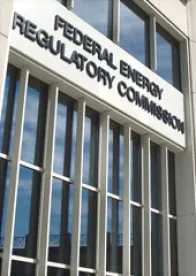On November 18, 2021, the Federal Energy Regulatory Commission (“FERC”) issued a notice of inquiry seeking comment on a broad array of issues related to FERC’s policies respecting compensation to generation owners—including conventional resources, renewable resources, and resources interconnected to the distribution system—for their reactive power capabilities (“NOI”).1 An NOI is an information-gathering proceeding used by FERC to determine whether to move forward with more formal action to change Commission rules or requirements. Though the issuance of an NOI does not necessarily mean that FERC will move forward, FERC action in the areas touched on in the NOI could have significant implications for generators’ reactive power compensation, including their ability to receive separate compensation for reactive capability.
The NOI poses a detailed set of questions across three areas of inquiry:
(1) whether FERC should amend its AEP methodology, the leading methodology for setting cost-based reactive power rates that FERC established two decades ago in American Electric Power Service Corp., Opinion No. 440, 88 FERC ¶ 61,141 (1999);
(2) whether FERC should consider alternatives to the AEP methodology (e.g., a new flat rate methodology or a methodology based on replacement costs); and
(3) how to treat resources interconnected to the distribution system that participate in wholesale markets with respect to compensation for reactive power.
Below we provide background on FERC’s reactive power compensation policies and an overview of the three primary issues teed-up in the NOI. Comments on the NOI are due 60 days following its publication in the Federal Register, with reply comments due 30 days thereafter.
Background: Reactive power—as opposed to real power, which turns our lights on—is needed to maintain voltage levels for transmission system reliability. In Order No. 888, in 1996, FERC identified “reactive supply and voltage control from generation sources” as one of six ancillary services included in in transmission providers’ pro forma open access transmission tariffs.2 At that time, FERC explained that absent proof a generation owner lacks market power with respect to providing reactive power, compensation for its reactive power capability should be cost-based. Over the years, different approaches to compensating generators that provide reactive power capability have developed across the various centralized markets. For example, in PJM and MISO, generation owners use the AEP methodology to establish revenue requirements on a resource-specific or fleet-wide basis. In ISO-NE and NYISO, in contrast, reactive power compensation occurs on a flat-rate basis, based on the generation resource’s tested reactive capability (though in ISO-NE, certain variable costs are added to the flat rate). In CAISO, SPP, and some non-RTO regions, transmission operators do not separately compensate generation resources for reactive power capability.
Issue One: Potential Updates to the AEP methodology. FERC explains that industry has experienced significant changes in the more than two decades since AEP was decided. FERC points out that at the time of AEP, “the majority of reactive power filings were made by synchronous resources that were owned by public utilities” that were subject to FERC’s Uniform System of Accounts (“USoA”) and filed detailed cost data annually in a FERC Form No. 1. In recent years, however, there has been a significant increase in the number of reactive power rate filings made by owners of non-synchronous resources, including wind, solar, and energy storage resources, whose costs may not perfectly align with the categories of costs set out in AEP. In addition, many of the generation owners seeking reactive power revenue today have received waivers from FERC’s USoA and Form No. 1 requirements.
FERC explains that these changes have created challenges in FERC’s evaluation of reactive power rate filings because generation owners’ records of relevant costs may not be maintained or presented to FERC in a uniform way. The challenges have been acute in PJM and MISO, where FERC has processed more than 385 filings over the past six years and, of those, has set at least 135 for hearing and settlement procedures.3 In response to these challenges, FERC asks a detailed series of questions related to its reliance on the AEP methodology. Among other things, the questions seek stakeholder comment on:
-
whether it is still appropriate to base reactive power compensation on a resource’s cost of investment in reactive power capability;
-
what the appropriate time period is for reactive power compensation (e.g., should payments be limited based on useful plant life);
-
how a resource’s reactive power capability degrades over time and how to reflect such degradation in compensation;
-
whether the AEP methodology is appropriate for non-synchronous resources, and if not, what specific changes may be required; and
-
what type of evidentiary support is needed to substantiate a filer’s proposed reactive power capability revenue requirement, and should filers be required to submit standardized forms or schedules.
Issue Two: Potential alternatives to the AEP methodology. FERC also seeks input on potential alternatives to the AEP methodology and—notably—the merits of separately compensating resources for reactive power capability in regions with centralized capacity markets. Specifically, in response to views expressed by the PJM market monitor, the Commission requests comment on whether generation resources in regions with centralized capacity markets should be required to recover the costs of their investment in reactive power capability by embedding those costs in their capacity market offers rather than through a separate, stand-alone, cost-based rate.
The Commission also offers up two specific alternatives to the AEP methodology for comment. First, FERC seeks comment on the use of a flat rate methodology “based on the total reactive power payments made by transmission customers in a region divided by the MVARs consumed in the region.” FERC notes that this approach could feature different values for each resource class (i.e., solar, wind turbine, combined-cycle, combustion turbine, and hydro) or a single value for all resource classes. Second, FERC seeks comment on the use of a replacement cost ratemaking approach, which would use a lowest-cost technology capable of providing reactive power capability to establish a per-MVAR-year rate.
Issue Three: Resources interconnected to the distribution system. FERC seeks comment on whether resources interconnected to the distribution system that participate in wholesale markets “are technically capable of providing reactive power to the transmission system in such a way that these resources should be eligible for reactive power capability compensation through transmission rates.” In the NOI, FERC notes that it previously has found that a transmission provider need not compensate a resource for reactive power if it is not under the control of the control area operator. FERC asks a variety of questions regarding the technical capabilities of distribution-connected resources to provide reactive power to transmission providers and whether such resources are dispatchable by transmission providers.
What action, if any, the Commission takes in response to the input it receives on these questions could have significant implications for the ability of distributed energy resources to receive reactive power compensation. In PJM, owners of distributed energy resources have successfully established reactive rate schedules entitling them to receive compensation for their reactive capability; very recently, however, the PJM market monitor has protested the eligibility of resources interconnected to the distribution system to receive such compensation. In MISO, the market operator has taken the position that the MISO Tariff does not permit resources interconnected at the distribution level to receive such compensation. A decision by the Commission to more formally recognize that distributed energy resources can have the capability to provide reactive support to the transmission grid could help eliminate existing barriers to the receipt of compensation by such resources; however, a determination otherwise could jeopardize the compensation of those distributed energy resources that have established reactive revenue requirements and limit the availability of reactive compensation for additional, similarly situated resources going forward.
1. Reactive Power Capability Compensation, 177 FERC ¶ 61,118 (2021).
2. Transmission customers taking service under a pro forma OATT purchase or provide ancillary services themselves to support the OATT transmission service they purchased. Pro forma OATTs include rates for purchasing such ancillary services from the transmission provider.
3. Both MISO and PJM require generation owners to submit notice to FERC any time a generation owner with a reactive power rate schedule on file with FERC plans to sell the generation asset or there is a proposed transfer of control over the generation owner. The notice is intended to demonstrate that the reactive power revenue requirement for the generation facility at issue remains just and reasonable following the proposed transaction. FERC frequently sets these notice submittals for FERC hearing and settlement procedures and the resulting proceedings are frequently extended and use significant FERC and industry resources.





 />i
/>i
